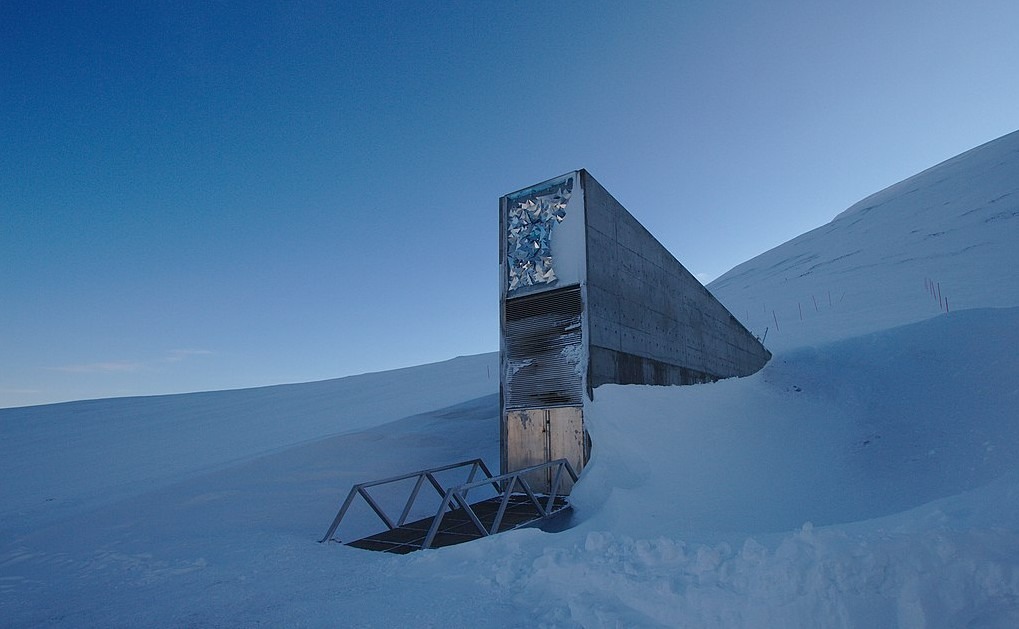The Svalbard Global Seed Vault is a secure seed bank on Spitsbergen, a Norwegian island of the Arctic Svalbard archipelago. Since it is only about 1,300 kilometers (or 810 miles) from the North Pole, the Svalbard Global Seed Vault is as remote as it can get. A seed bank, in simplest terms, is like a safe deposit of a bank. But instead of depositing money or currency, you deposit plant seeds.
The Svalbard Global Seed Vault is one of the largest seed banks in the world. It is generally referred to as the “doomsday” seed vault, or (according to media) the “Noah’s Ark of plant diversity.”
History and overview
Founder Cary Fowler at the construction of the Svalbard seed vault
Conservationist Cary Fowler, in collaboration with Consultative Group on International Agricultural Research (CGIAR), founded the Svalbard Global Seed Vault in 2008. It houses about 4.5 million various seed samples from all over the world or about 2.25 billion seeds in total. The vault ensures food production and sustainable agriculture in the event of global crises such as wars, natural disasters, climate change, extinction – and even the direst ones such as asteroids, nuclear bombs, and perhaps a global pandemic.
It is managed by the Global Crop Diversity Trust (GCDT), the Nordic Genetic Resource Center (NordGen), and the Norwegian government. GCDT gets its funds from various organizations, such as the Bill & Melinda Gates Foundation, as well as several governments worldwide. The Norwegian government paid for the vault’s construction, which cost 45 million Norwegian kroner (US$9 million). Both the Norwegian government and GCDT shoulder the vault’s operational expenses. The storing of the seeds in the vault is completely free of charge to end-users. It continues to accept seeds of various strains.
Svalbard Global Seed Vault’s collection is chiefly composed of seeds from developing countries. The vault even has seed samples from North Korea!
It seems that the frigid, below-zero Arctic conditions provide a perfect place to preserve those seeds. The vault is sunk through the deep permafrost, which provides “fail-safe” protection against the global crises earlier mentioned.
Physical features of the vault
The exterior of the vault certainly merits some interest. It is quite typical of a modern European architectural design. The vault features a sharp concrete edge that cuts its way out from within a mountain and has an illuminating art installation that faces out from the front. The artwork consists of highly reflective stainless steel, prisms, and mirrors, all of which reflect light in every direction. The eye-catching artwork, titled “Perpetual Repercussion,” was created by Norwegian artist Dyveke Sanne. Sanne herself put her own thoughts about the seed vault:
“The existence of the seed vault reminds us of our own place in the whole and of the condition of the Earth. The seeds commit us to a future. They are biodiverse copies that demand cyclical repetition in action instead of a continuing faith in appointed originals and linear progress.”
Because the vault itself is buried very deep into the permafrost, the temperature does not exceed minus four degrees Celsius. The room temperature will remain very much the same, even in cases such as power failure and eventual malfunction of the vault’s cooling system. According to the official newsletter The Svalbard (Svalbardposten in Norwegian), power cuts are quite a normal occurrence. In October 2016, the vault experienced an unusually large volume of water intrusion, which was caused by storms and heavy rainfall. The water caused damage to the fuses, but fortunately, it never got anywhere near the seeds.
Access to the seeds
Depositing the seeds is quite a normal thing to do at Svalbard seed vault. But have the seeds been actually withdrawn? Yes, apparently.
When civil war broke out in Syria, the seed bank in Aleppo was affected and had to be moved out to Beirut, Lebanon. But due to the difficulties in transferring the seed collection, the Svalbard Global Seed Vault stepped in and authorized its first withdrawal of the seeds in 2015. The seeds were then grown and harvested before new seeds were to be returned to the vault. That’s how amazing the Svalbard Global Seed Vault truly is!
While Svalbard Global Seed Vault is not open to the public, Svalbard Science Destination organizes guided tours that will take visitors close to the entrance.
For more information about Svalbard Global Seed Bank, visit the official website seedvault.no.
